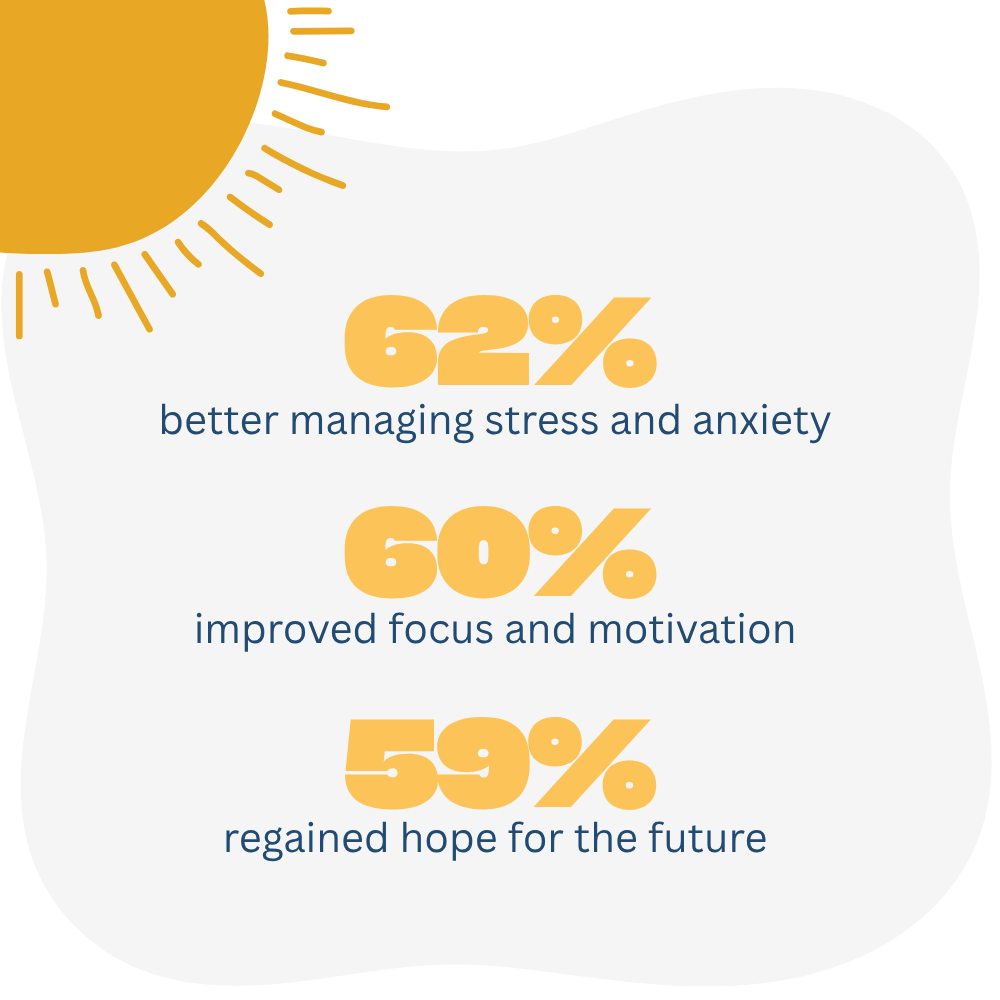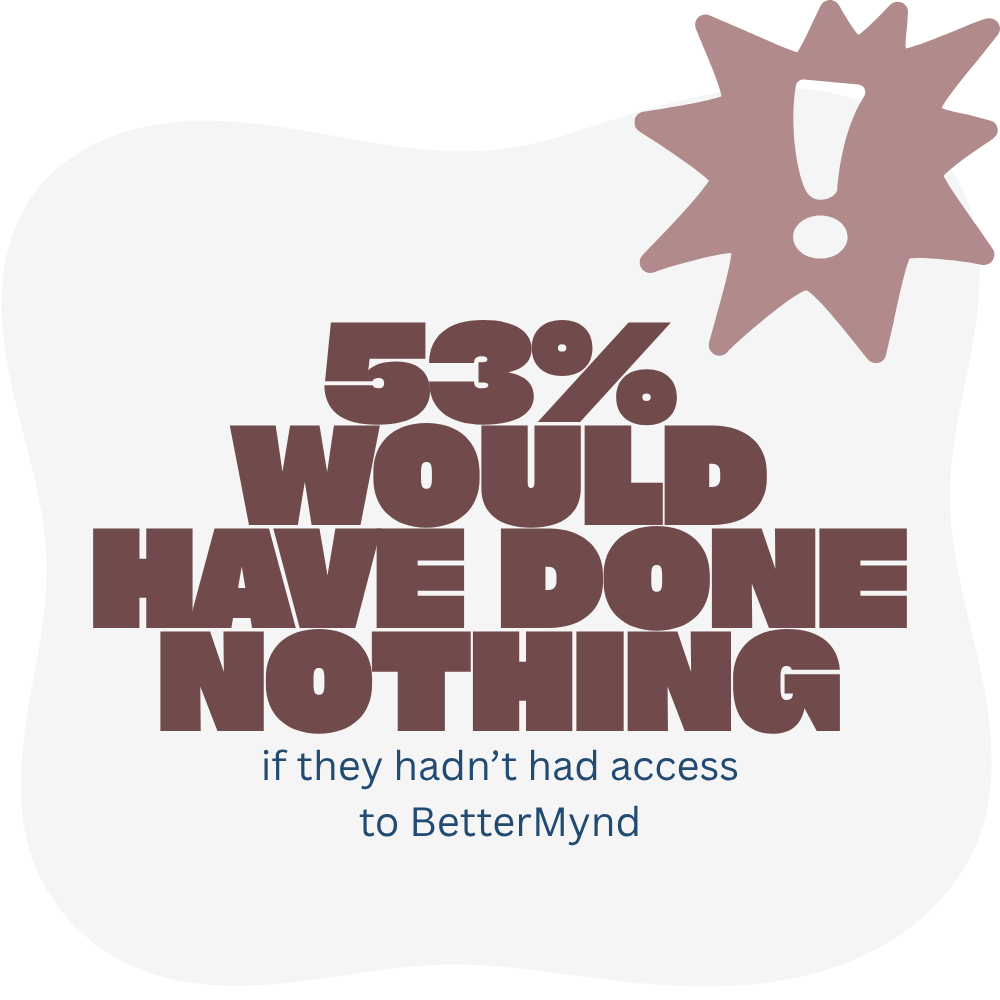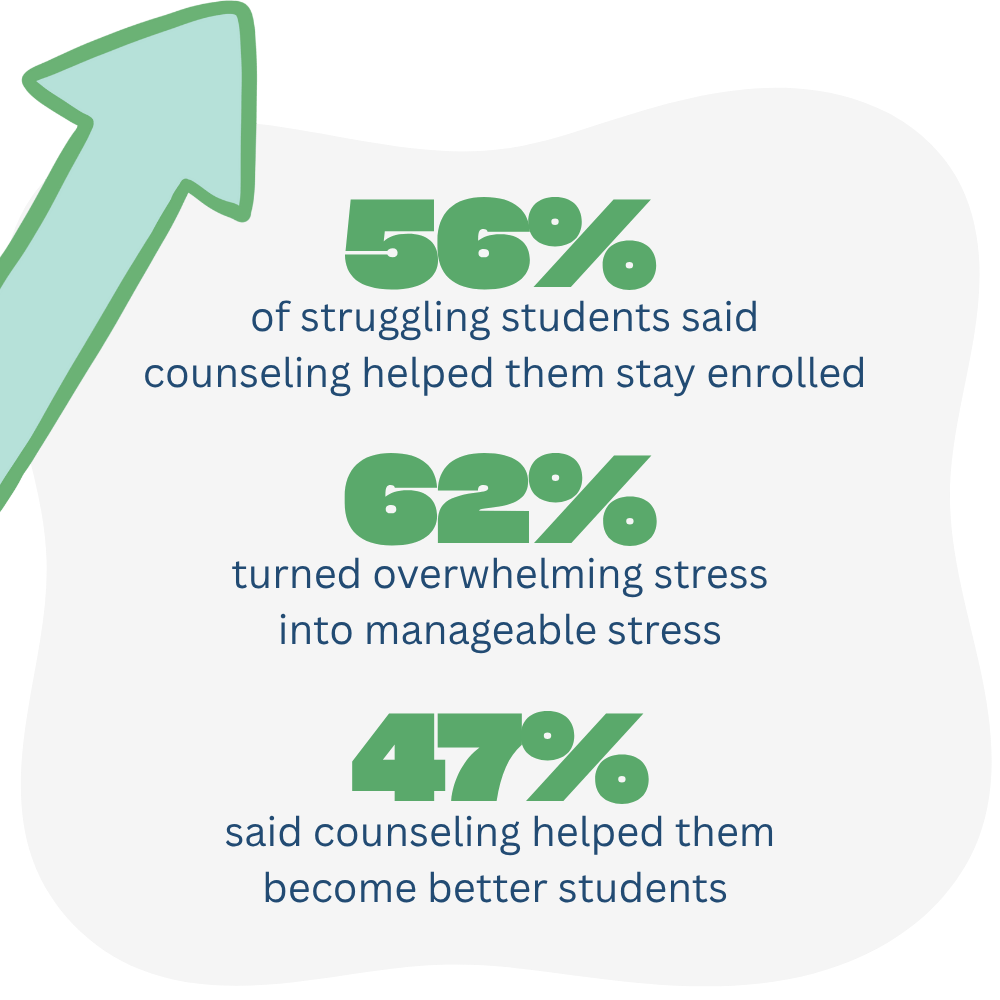The Real Story Behind Student Mental Health: Beyond Surface Solutions
When a student says, “I’m struggling,” it rarely means just one thing.
Our 2024-25 Student Survey confirmed what many campus leaders already see every day: student challenges don’t happen in silos. They stack, overlap, and weigh heavier over time. On average, students named nearly five struggles before counseling.
A student who checked “anxiety” also checked “motivation.” A student who felt disconnected from campus also questioned their future. This is the reality of modern student life: struggles are interconnected — and so must be the solutions.
Student Outcomes: From Struggle to Progress
The encouraging news is that students can — and do — make meaningful progress when given access to the right kind of support. BetterMynd contributes to more than emotional and personal well-being — it empowers persistence, belonging, and long-term success inside and outside the classroom.
Survey respondents reported:
- 62% better managing stress and anxiety
- 60% improved focus and motivation
- 59% regained hope for the future
For counseling and university center directors, this reflects clinical progress: students aren’t just naming problems, they’re learning to manage them — which can help reduce crises and long-term dependence on services. For student affairs leaders, the outcomes ripple upward: every student who shifts from “I can’t handle this” to “I’m managing” is also more likely to remain enrolled.
Reaching Students Who Wouldn’t Otherwise Seek Help
One of the most pressing insights is about who gets reached. More than half of surveyed students (53%) said they would have done nothing if they hadn’t had access to BetterMynd. Many had already tried other pathways — 64% sought off-campus counseling, 33% tried on-campus — but still needed a different entry point.
This suggests that campuses aren’t just competing against stigma; they’re competing against gaps in fit, timing, and flexibility. Models that reduce barriers — whether through usage-based pricing, counselor choice, or privacy and cultural alignment — are finding students who would otherwise remain unseen.
For counseling centers, this relieves pressure on their staff by helping students who would otherwise remain on waitlist. For student affairs, it brings hidden students back into the fold of campus life.
Why Student Mental Health Data Matters to Institutions
For some students, leaving school is truly the healthiest decision — a reality that counseling center directors know well. But the data shows that many students can stay enrolled when their struggles are addressed early and effectively.
- 56% of struggling students said counseling helped them stay enrolled
- 62% turned overwhelming stress into manageable stress
- 47% said counseling helped them become better students
Those percentages translate into tuition retained, classrooms filled, and students better prepared to succeed. They also underscore a truth leaders can’t afford to miss: mental health isn’t just about wellness; it’s about institutional sustainability.
Importantly, this isn’t about achieving retention at all costs. It’s about ensuring students make decisions from a place of stability rather than crisis — something both counseling center directors and student affairs leaders can align on.
The BetterMynd Difference in Action
So what does this look like in practice? BetterMynd has shown how these principles translate into outcomes that matter for both students and institutions:
- Flexible & personalized: Students choose the counselor (and availability) that fits them best.
- Safe to begin: Many students hesitate until they feel “ready” — BetterMynd normalizes starting wherever they are.
- Consistency builds trust: Since 2017, BetterMynd has stayed true to its usage-based, rollover model — designed to increase access.
While others focus on how many students sign up, BetterMynd focuses on the ones who show up — and ensures their experience creates lasting change.
That’s the BetterMynd difference in action.
Frequently Asked Questions
Q: What does the BetterMynd 2024-25 Student Survey measure?
A: The survey asked students about their challenges before starting counseling and their progress after participating. It highlights how student struggles overlap — with an average of nearly five challenges per student — and tracks measurable improvements in stress, motivation, hope, and belonging.
Q: Why do these outcomes matter to counseling center directors?
A: Directors often face waitlists, high student demand, and concerns about staff capacity. The survey shows that students who engage in flexible counseling models make meaningful progress — reducing crisis severity, improving coping skills, and reaching hidden students who otherwise wouldn’t seek help.
Q: Why is this data important for student affairs leaders?
A: For VPs of Student Affairs, these outcomes connect directly to retention and graduation. The survey found that 56% of struggling students said counseling helped them stay enrolled, and 47% said it helped them become better students. That translates into tuition retained and stronger academic outcomes.
Q: What kinds of student challenges improved the most?
A: Students reported the strongest progress in internal challenges:
- 62% better managing stress and anxiety
- 60% improved focus and motivation
- 59% regained hope for the future
Q: Who are the “hidden students” the survey identifies?
A: More than half of students (53%) said they would have done nothing without BetterMynd. Many had already tried off-campus or on-campus counseling, but barriers like cost, fit, or readiness kept them from continuing. Flexible, usage-based models help reach these hidden students.
Q: How does BetterMynd’s model support both counseling centers and institutions?
A: BetterMynd reduces barriers with usage-based pricing, counselor choice, and flexible access. For counseling centers, this alleviates waitlist pressure and engages students earlier. For institutions, it means more students stay enrolled, connected, and supported.

![[CURRENT] Website Images_Oct 2025 (1)](https://www.bettermynd.com/wp-content/uploads/2025/10/CURRENT-Website-Images_Oct-2025-1.png)
![[CURRENT] Website Images_Oct 2025](https://www.bettermynd.com/wp-content/uploads/2025/10/CURRENT-Website-Images_Oct-2025-2.png)



